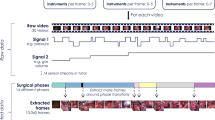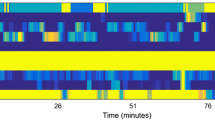Abstract
Purpose
With the intention of extending the perception and action of surgical staff inside the operating room, the medical community has expressed a growing interest towards context-aware systems. Requiring an accurate identification of the surgical workflow, such systems make use of data from a diverse set of available sensors. In this paper, we propose a fully data-driven and real-time method for segmentation and recognition of surgical phases using a combination of video data and instrument usage signals, exploiting no prior knowledge. We also introduce new validation metrics for assessment of workflow detection.
Methods
The segmentation and recognition are based on a four-stage process. Firstly, during the learning time, a Surgical Process Model is automatically constructed from data annotations to guide the following process. Secondly, data samples are described using a combination of low-level visual cues and instrument information. Then, in the third stage, these descriptions are employed to train a set of AdaBoost classifiers capable of distinguishing one surgical phase from others. Finally, AdaBoost responses are used as input to a Hidden semi-Markov Model in order to obtain a final decision.
Results
On the MICCAI EndoVis challenge laparoscopic dataset we achieved a precision and a recall of 91 % in classification of 7 phases.
Conclusion
Compared to the analysis based on one data type only, a combination of visual features and instrument signals allows better segmentation, reduction of the detection delay and discovery of the correct phase order.



Similar content being viewed by others
References
Bardram J, Doryab A, Jensen R, Lange P, Nielsen K, Petersen S (2011) Phase recognition during surgical procedures using embedded and body-worn sensors. In: IEEE international conference on pervasive computing and communications, pp 45–53
Bharathan R, Aggarwal R, Darzi A (2013) Operating room of the future. Best Pract Res Clin Obst Gynecol 27(3):311–322
Blum T, Feuner H, Navab N (2010) Modeling and segmentation of surgical workflow from laparoscopic video. In: Medical image computing and computer-assisted interventions, vol. 6363, pp 400–407
Bouget D, Benenson R, Omran M, Riffaud L, Schiele B, Jannin P (2015) Detecting surgical tools by modelling local appearance and global shape. IEEE Trans Med Imaging 34(12):2603–2617
Charriere K, Quellec G, Lamard M, Coatrieux G, Cochener B, Cazuguel G (2014) Automated surgical step recognition in normalized cataract surgery videos. In: IEEE international conference on engineering in medicine and biology society, pp 4647–4650
Cleary K, Kinsella A (2005) Or 2020: the operating room of the future. J Laparoendosc Adv Surg Tech 15(5):495–497
Despinoy F, Bouget D, Forestier G, Penet C, Zemiti N, Poignet P, Jannin P (2015) Unsupervised trajectory segmentation for surgical gesture recognition in robotic training. IEEE transactions on biomedical engineering. doi:10.1109/TBME.2015.2493100
Holden MS, Ungi T, Sargent D, McGraw RC, Chen EC, Ganapathy S, Peters TM, Fichtinger G (2014) Feasibility of real-time workflow segmentation for tracked needle interventions. IEEE Trans Biomed Eng 61(6):1720–1728
James A, Vieira D, Lo B, Darzi A, Yang GZ (2007) Eye-gaze driven surgical workflow segmentation. In: medical image computing and computer-assisted interventions, pp 110–117
Jannin P, Morandi X (2007) Surgical models for computer-assisted neurosurgery. NeuroImage 37(3):783–791
Lalys F, Jannin P (2014) Surgical process modelling: a review. Int J Comput Assist Radiol Surg 9(3):495–511
Lalys F, Riffaud L, Bouget D, Jannin P (2012) A framework for the recognition of high-level surgical tasks from video images for cataract surgeries. IEEE Trans Biomed Eng 59(4):966–976
Lo B, Darzi A, Yang GZ (2003) Episode classification for the analysis of tissue/instrument interaction with multiple visual cues. In: Medical image computing and computer-assisted interventions, vol 2878, pp 230–237
Nara A, Izumi K, Iseki H, Suzuki T, Nambu K, Sakurai Y (2011) Surgical workflow monitoring based on trajectory data mining. In: New frontiers in artificial intelligence, vol 6797, pp 283–291
Padoy N, Blum T, Essa I, Feussner H, Berger MO, Navab N (2007) A boosted segmentation method for surgical workflow analysis. In: Medical image computing and computer-assisted interventions, vol 4791, pp 102–109
Padoy N, Blum T, Ahmadi SA, Feussner H, Berger MO, Navab N (2012) Statistical modeling and recognition of surgical workflow. Med Image Anal 16(3):632–641
Quellec G, Lamard M, Cochener B, Cazuguel G (2014) Real-time segmentation and recognition of surgical tasks in cataract surgery videos. IEEE Trans Med Imaging 33(12):2352–2360
Rabiner LR (1989) A tutorial on hidden Markov models and selected applications in speech recognition. Proc IEEE 77(2):257–286
Schapire RE (2003) The boosting approach to machine learning: An overview. In: Nonlinear estimation and classification, pp 149–171
Stauder R, Okur A, Navab N (2014) Detecting and analyzing the surgical workflow to aid human and robotic scrub nurses. In: The Hamlyn Symposium on Medical Robotics, p 91
Weede O, Dittrich F, Worn H, Jensen B, Knoll A, Wilhelm D, Kranzfelder M, Schneider A, Feussner H (2012) Workflow analysis and surgical phase recognition in minimally invasive surgery. In: IEEE international conference on robotics and biomimetics, pp 1080–1074
Yu SZ, Kobayashi H (2003) An efficient forward-backward algorithm for an explicit-duration hidden markov model. IEEE Signal Process Lett 10(1):11–14
Acknowledgments
This work was partially supported by French state funds managed by the ANR within the Investissements d’Avenir Program (Labex CAMI) under the reference ANR-11-LABX-0004.
Author information
Authors and Affiliations
Corresponding author
Ethics declarations
Conflict of interest
Olga Dergachyova, David Bouget, Arnaud Huaulmé, Xavier Morandi and Pierre Jannin declare that they have no conflict of interest.
Ethical approval
For this type of study formal consent is not required.
Informed consent
Not required. Used data were anonymously available through the MICCAI EndoVis challenge.
Rights and permissions
About this article
Cite this article
Dergachyova, O., Bouget, D., Huaulmé, A. et al. Automatic data-driven real-time segmentation and recognition of surgical workflow. Int J CARS 11, 1081–1089 (2016). https://doi.org/10.1007/s11548-016-1371-x
Received:
Accepted:
Published:
Issue Date:
DOI: https://doi.org/10.1007/s11548-016-1371-x




